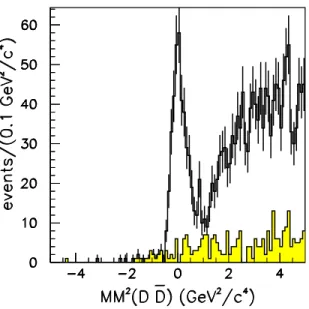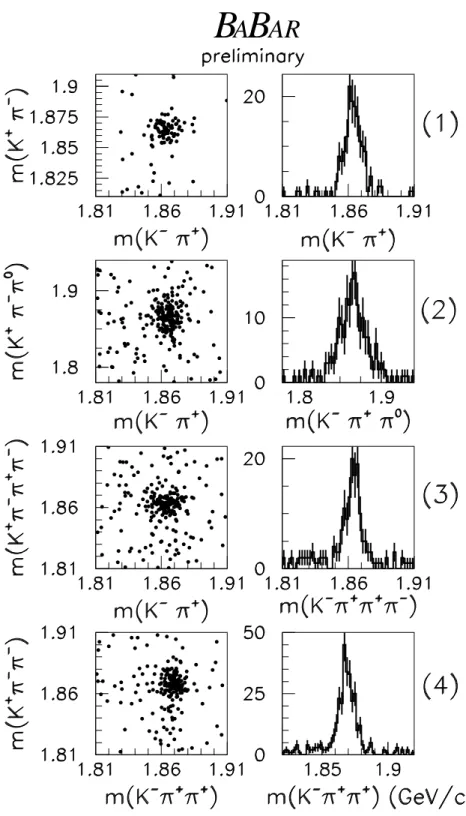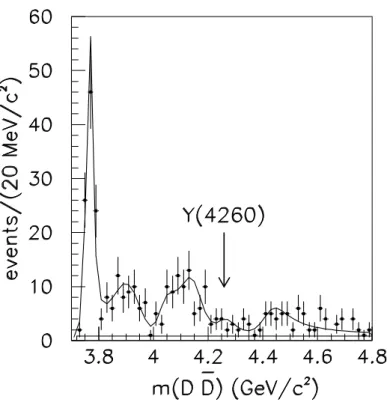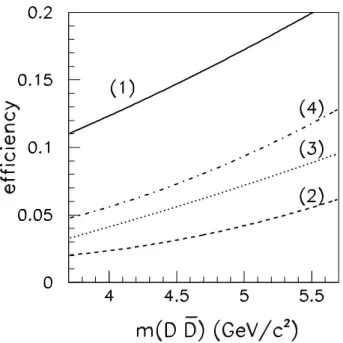arXiv:hep-ex/0607083v1 27 Jul 2006
B
AB
AR-CONF-06/33
SLAC-PUB-11983
Study of the Exclusive Initial-State Radiation Production of the
D ¯
D System
The BABARCollaboration,
B. Aubert, R. Barate, M. Bona, D. Boutigny, F. Couderc, Y. Karyotakis, J. P. Lees, V. Poireau, V. Tisserand, A. Zghiche
Laboratoire de Physique des Particules, IN2P3/CNRS et Universit´e de Savoie, F-74941 Annecy-Le-Vieux, France
E. Grauges
Universitat de Barcelona, Facultat de Fisica, Departament ECM, E-08028 Barcelona, Spain A. Palano
Universit`a di Bari, Dipartimento di Fisica and INFN, I-70126 Bari, Italy J. C. Chen, N. D. Qi, G. Rong, P. Wang, Y. S. Zhu
Institute of High Energy Physics, Beijing 100039, China G. Eigen, I. Ofte, B. Stugu
University of Bergen, Institute of Physics, N-5007 Bergen, Norway
G. S. Abrams, M. Battaglia, D. N. Brown, J. Button-Shafer, R. N. Cahn, E. Charles, M. S. Gill, Y. Groysman, R. G. Jacobsen, J. A. Kadyk, L. T. Kerth, Yu. G. Kolomensky, G. Kukartsev, G. Lynch,
L. M. Mir, T. J. Orimoto, M. Pripstein, N. A. Roe, M. T. Ronan, W. A. Wenzel
Lawrence Berkeley National Laboratory and University of California, Berkeley, California 94720, USA P. del Amo Sanchez, M. Barrett, K. E. Ford, A. J. Hart, T. J. Harrison, C. M. Hawkes, S. E. Morgan,
A. T. Watson
University of Birmingham, Birmingham, B15 2TT, United Kingdom
T. Held, H. Koch, B. Lewandowski, M. Pelizaeus, K. Peters, T. Schroeder, M. Steinke Ruhr Universit¨at Bochum, Institut f¨ur Experimentalphysik 1, D-44780 Bochum, Germany
J. T. Boyd, J. P. Burke, W. N. Cottingham, D. Walker University of Bristol, Bristol BS8 1TL, United Kingdom
D. J. Asgeirsson, T. Cuhadar-Donszelmann, B. G. Fulsom, C. Hearty, N. S. Knecht, T. S. Mattison, J. A. McKenna
University of British Columbia, Vancouver, British Columbia, Canada V6T 1Z1 A. Khan, P. Kyberd, M. Saleem, D. J. Sherwood, L. Teodorescu
Brunel University, Uxbridge, Middlesex UB8 3PH, United Kingdom
V. E. Blinov, A. D. Bukin, V. P. Druzhinin, V. B. Golubev, A. P. Onuchin, S. I. Serednyakov, Yu. I. Skovpen, E. P. Solodov, K. Yu Todyshev
D. S. Best, M. Bondioli, M. Bruinsma, M. Chao, S. Curry, I. Eschrich, D. Kirkby, A. J. Lankford, P. Lund, M. Mandelkern, R. K. Mommsen, W. Roethel, D. P. Stoker
University of California at Irvine, Irvine, California 92697, USA S. Abachi, C. Buchanan
University of California at Los Angeles, Los Angeles, California 90024, USA S. D. Foulkes, J. W. Gary, O. Long, B. C. Shen, K. Wang, L. Zhang University of California at Riverside, Riverside, California 92521, USA
H. K. Hadavand, E. J. Hill, H. P. Paar, S. Rahatlou, V. Sharma University of California at San Diego, La Jolla, California 92093, USA
J. W. Berryhill, C. Campagnari, A. Cunha, B. Dahmes, T. M. Hong, D. Kovalskyi, J. D. Richman University of California at Santa Barbara, Santa Barbara, California 93106, USA
T. W. Beck, A. M. Eisner, C. J. Flacco, C. A. Heusch, J. Kroseberg, W. S. Lockman, G. Nesom, T. Schalk, B. A. Schumm, A. Seiden, P. Spradlin, D. C. Williams, M. G. Wilson
University of California at Santa Cruz, Institute for Particle Physics, Santa Cruz, California 95064, USA J. Albert, E. Chen, A. Dvoretskii, F. Fang, D. G. Hitlin, I. Narsky, T. Piatenko, F. C. Porter, A. Ryd,
A. Samuel
California Institute of Technology, Pasadena, California 91125, USA G. Mancinelli, B. T. Meadows, K. Mishra, M. D. Sokoloff
University of Cincinnati, Cincinnati, Ohio 45221, USA
F. Blanc, P. C. Bloom, S. Chen, W. T. Ford, J. F. Hirschauer, A. Kreisel, M. Nagel, U. Nauenberg, A. Olivas, W. O. Ruddick, J. G. Smith, K. A. Ulmer, S. R. Wagner, J. Zhang
University of Colorado, Boulder, Colorado 80309, USA
A. Chen, E. A. Eckhart, A. Soffer, W. H. Toki, R. J. Wilson, F. Winklmeier, Q. Zeng Colorado State University, Fort Collins, Colorado 80523, USA
D. D. Altenburg, E. Feltresi, A. Hauke, H. Jasper, J. Merkel, A. Petzold, B. Spaan Universit¨at Dortmund, Institut f¨ur Physik, D-44221 Dortmund, Germany
T. Brandt, V. Klose, H. M. Lacker, W. F. Mader, R. Nogowski, J. Schubert, K. R. Schubert, R. Schwierz, J. E. Sundermann, A. Volk
Technische Universit¨at Dresden, Institut f¨ur Kern- und Teilchenphysik, D-01062 Dresden, Germany D. Bernard, G. R. Bonneaud, E. Latour, Ch. Thiebaux, M. Verderi
Laboratoire Leprince-Ringuet, CNRS/IN2P3, Ecole Polytechnique, F-91128 Palaiseau, France P. J. Clark, W. Gradl, F. Muheim, S. Playfer, A. I. Robertson, Y. Xie
University of Edinburgh, Edinburgh EH9 3JZ, United Kingdom
M. Andreotti, D. Bettoni, C. Bozzi, R. Calabrese, G. Cibinetto, E. Luppi, M. Negrini, A. Petrella, L. Piemontese, E. Prencipe
F. Anulli, R. Baldini-Ferroli, A. Calcaterra, R. de Sangro, G. Finocchiaro, S. Pacetti, P. Patteri, I. M. Peruzzi,1
M. Piccolo, M. Rama, A. Zallo
Laboratori Nazionali di Frascati dell’INFN, I-00044 Frascati, Italy
A. Buzzo, R. Capra, R. Contri, M. Lo Vetere, M. M. Macri, M. R. Monge, S. Passaggio, C. Patrignani, E. Robutti, A. Santroni, S. Tosi
Universit`a di Genova, Dipartimento di Fisica and INFN, I-16146 Genova, Italy G. Brandenburg, K. S. Chaisanguanthum, M. Morii, J. Wu
Harvard University, Cambridge, Massachusetts 02138, USA R. S. Dubitzky, J. Marks, S. Schenk, U. Uwer
Universit¨at Heidelberg, Physikalisches Institut, Philosophenweg 12, D-69120 Heidelberg, Germany D. Bard, W. Bhimji, D. A. Bowerman, P. D. Dauncey, U. Egede, R. L. Flack, J .A. Nash, M. B. Nikolich,
W. Panduro Vazquez
Imperial College London, London, SW7 2AZ, United Kingdom P. K. Behera, X. Chai, M. J. Charles, U. Mallik, N. T. Meyer, V. Ziegler
University of Iowa, Iowa City, Iowa 52242, USA
J. Cochran, H. B. Crawley, L. Dong, V. Eyges, W. T. Meyer, S. Prell, E. I. Rosenberg, A. E. Rubin Iowa State University, Ames, Iowa 50011-3160, USA
A. V. Gritsan
Johns Hopkins University, Baltimore, Maryland 21218, USA A. G. Denig, M. Fritsch, G. Schott
Universit¨at Karlsruhe, Institut f¨ur Experimentelle Kernphysik, D-76021 Karlsruhe, Germany N. Arnaud, M. Davier, G. Grosdidier, A. H¨ocker, F. Le Diberder, V. Lepeltier, A. M. Lutz, A. Oyanguren,
S. Pruvot, S. Rodier, P. Roudeau, M. H. Schune, A. Stocchi, W. F. Wang, G. Wormser Laboratoire de l’Acc´el´erateur Lin´eaire, IN2P3/CNRS et Universit´e Paris-Sud 11, Centre Scientifique
d’Orsay, B.P. 34, F-91898 ORSAY Cedex, France C. H. Cheng, D. J. Lange, D. M. Wright
Lawrence Livermore National Laboratory, Livermore, California 94550, USA
C. A. Chavez, I. J. Forster, J. R. Fry, E. Gabathuler, R. Gamet, K. A. George, D. E. Hutchcroft, D. J. Payne, K. C. Schofield, C. Touramanis
University of Liverpool, Liverpool L69 7ZE, United Kingdom A. J. Bevan, F. Di Lodovico, W. Menges, R. Sacco Queen Mary, University of London, E1 4NS, United Kingdom
G. Cowan, H. U. Flaecher, D. A. Hopkins, P. S. Jackson, T. R. McMahon, S. Ricciardi, F. Salvatore, A. C. Wren
University of London, Royal Holloway and Bedford New College, Egham, Surrey TW20 0EX, United Kingdom
1
D. N. Brown, C. L. Davis
University of Louisville, Louisville, Kentucky 40292, USA
J. Allison, N. R. Barlow, R. J. Barlow, Y. M. Chia, C. L. Edgar, G. D. Lafferty, M. T. Naisbit, J. C. Williams, J. I. Yi
University of Manchester, Manchester M13 9PL, United Kingdom C. Chen, W. D. Hulsbergen, A. Jawahery, C. K. Lae, D. A. Roberts, G. Simi
University of Maryland, College Park, Maryland 20742, USA
G. Blaylock, C. Dallapiccola, S. S. Hertzbach, X. Li, T. B. Moore, S. Saremi, H. Staengle University of Massachusetts, Amherst, Massachusetts 01003, USA
R. Cowan, G. Sciolla, S. J. Sekula, M. Spitznagel, F. Taylor, R. K. Yamamoto
Massachusetts Institute of Technology, Laboratory for Nuclear Science, Cambridge, Massachusetts 02139, USA
H. Kim, S. E. Mclachlin, P. M. Patel, S. H. Robertson McGill University, Montr´eal, Qu´ebec, Canada H3A 2T8
A. Lazzaro, V. Lombardo, F. Palombo
Universit`a di Milano, Dipartimento di Fisica and INFN, I-20133 Milano, Italy
J. M. Bauer, L. Cremaldi, V. Eschenburg, R. Godang, R. Kroeger, D. A. Sanders, D. J. Summers, H. W. Zhao
University of Mississippi, University, Mississippi 38677, USA S. Brunet, D. Cˆot´e, M. Simard, P. Taras, F. B. Viaud
Universit´e de Montr´eal, Physique des Particules, Montr´eal, Qu´ebec, Canada H3C 3J7 H. Nicholson
Mount Holyoke College, South Hadley, Massachusetts 01075, USA N. Cavallo,2
G. De Nardo, F. Fabozzi,3
C. Gatto, L. Lista, D. Monorchio, P. Paolucci, D. Piccolo, C. Sciacca
Universit`a di Napoli Federico II, Dipartimento di Scienze Fisiche and INFN, I-80126, Napoli, Italy M. A. Baak, G. Raven, H. L. Snoek
NIKHEF, National Institute for Nuclear Physics and High Energy Physics, NL-1009 DB Amsterdam, The Netherlands
C. P. Jessop, J. M. LoSecco
University of Notre Dame, Notre Dame, Indiana 46556, USA
T. Allmendinger, G. Benelli, L. A. Corwin, K. K. Gan, K. Honscheid, D. Hufnagel, P. D. Jackson, H. Kagan, R. Kass, A. M. Rahimi, J. J. Regensburger, R. Ter-Antonyan, Q. K. Wong
Ohio State University, Columbus, Ohio 43210, USA
2
Also with Universit`a della Basilicata, Potenza, Italy
3
N. L. Blount, J. Brau, R. Frey, O. Igonkina, J. A. Kolb, M. Lu, R. Rahmat, N. B. Sinev, D. Strom, J. Strube, E. Torrence
University of Oregon, Eugene, Oregon 97403, USA
A. Gaz, M. Margoni, M. Morandin, A. Pompili, M. Posocco, M. Rotondo, F. Simonetto, R. Stroili, C. Voci Universit`a di Padova, Dipartimento di Fisica and INFN, I-35131 Padova, Italy
M. Benayoun, H. Briand, J. Chauveau, P. David, L. Del Buono, Ch. de la Vaissi`ere, O. Hamon, B. L. Hartfiel, M. J. J. John, Ph. Leruste, J. Malcl`es, J. Ocariz, L. Roos, G. Therin
Laboratoire de Physique Nucl´eaire et de Hautes Energies, IN2P3/CNRS, Universit´e Pierre et Marie Curie-Paris6, Universit´e Denis Diderot-Paris7, F-75252 Paris, France
L. Gladney, J. Panetta
University of Pennsylvania, Philadelphia, Pennsylvania 19104, USA M. Biasini, R. Covarelli
Universit`a di Perugia, Dipartimento di Fisica and INFN, I-06100 Perugia, Italy
C. Angelini, G. Batignani, S. Bettarini, F. Bucci, G. Calderini, M. Carpinelli, R. Cenci, F. Forti, M. A. Giorgi, A. Lusiani, G. Marchiori, M. A. Mazur, M. Morganti, N. Neri, G. Rizzo, J. J. Walsh Universit`a di Pisa, Dipartimento di Fisica, Scuola Normale Superiore and INFN, I-56127 Pisa, Italy
M. Haire, D. Judd, D. E. Wagoner
Prairie View A&M University, Prairie View, Texas 77446, USA
J. Biesiada, N. Danielson, P. Elmer, Y. P. Lau, C. Lu, J. Olsen, A. J. S. Smith, A. V. Telnov Princeton University, Princeton, New Jersey 08544, USA
F. Bellini, G. Cavoto, A. D’Orazio, D. del Re, E. Di Marco, R. Faccini, F. Ferrarotto, F. Ferroni, M. Gaspero, L. Li Gioi, M. A. Mazzoni, S. Morganti, G. Piredda, F. Polci, F. Safai Tehrani, C. Voena
Universit`a di Roma La Sapienza, Dipartimento di Fisica and INFN, I-00185 Roma, Italy M. Ebert, H. Schr¨oder, R. Waldi
Universit¨at Rostock, D-18051 Rostock, Germany T. Adye, N. De Groot, B. Franek, E. O. Olaiya, F. F. Wilson
Rutherford Appleton Laboratory, Chilton, Didcot, Oxon, OX11 0QX, United Kingdom
R. Aleksan, S. Emery, A. Gaidot, S. F. Ganzhur, G. Hamel de Monchenault, W. Kozanecki, M. Legendre, G. Vasseur, Ch. Y`eche, M. Zito
DSM/Dapnia, CEA/Saclay, F-91191 Gif-sur-Yvette, France X. R. Chen, H. Liu, W. Park, M. V. Purohit, J. R. Wilson University of South Carolina, Columbia, South Carolina 29208, USA
M. T. Allen, D. Aston, R. Bartoldus, P. Bechtle, N. Berger, R. Claus, J. P. Coleman, M. R. Convery, M. Cristinziani, J. C. Dingfelder, J. Dorfan, G. P. Dubois-Felsmann, D. Dujmic, W. Dunwoodie, R. C. Field, T. Glanzman, S. J. Gowdy, M. T. Graham, P. Grenier,4
V. Halyo, C. Hast, T. Hryn’ova, W. R. Innes, M. H. Kelsey, P. Kim, D. W. G. S. Leith, S. Li, S. Luitz, V. Luth, H. L. Lynch,
4
D. B. MacFarlane, H. Marsiske, R. Messner, D. R. Muller, C. P. O’Grady, V. E. Ozcan, A. Perazzo, M. Perl, T. Pulliam, B. N. Ratcliff, A. Roodman, A. A. Salnikov, R. H. Schindler, J. Schwiening, A. Snyder, J. Stelzer, D. Su, M. K. Sullivan, K. Suzuki, S. K. Swain, J. M. Thompson, J. Va’vra, N. van Bakel, M. Weaver, A. J. R. Weinstein, W. J. Wisniewski, M. Wittgen, D. H. Wright, A. K. Yarritu, K. Yi,
C. C. Young
Stanford Linear Accelerator Center, Stanford, California 94309, USA P. R. Burchat, A. J. Edwards, S. A. Majewski, B. A. Petersen, C. Roat, L. Wilden
Stanford University, Stanford, California 94305-4060, USA
S. Ahmed, M. S. Alam, R. Bula, J. A. Ernst, V. Jain, B. Pan, M. A. Saeed, F. R. Wappler, S. B. Zain State University of New York, Albany, New York 12222, USA
W. Bugg, M. Krishnamurthy, S. M. Spanier University of Tennessee, Knoxville, Tennessee 37996, USA R. Eckmann, J. L. Ritchie, A. Satpathy, C. J. Schilling, R. F. Schwitters
University of Texas at Austin, Austin, Texas 78712, USA J. M. Izen, X. C. Lou, S. Ye
University of Texas at Dallas, Richardson, Texas 75083, USA F. Bianchi, F. Gallo, D. Gamba
Universit`a di Torino, Dipartimento di Fisica Sperimentale and INFN, I-10125 Torino, Italy M. Bomben, L. Bosisio, C. Cartaro, F. Cossutti, G. Della Ricca, S. Dittongo, L. Lanceri, L. Vitale
Universit`a di Trieste, Dipartimento di Fisica and INFN, I-34127 Trieste, Italy V. Azzolini, N. Lopez-March, F. Martinez-Vidal
IFIC, Universitat de Valencia-CSIC, E-46071 Valencia, Spain
Sw. Banerjee, B. Bhuyan, C. M. Brown, D. Fortin, K. Hamano, R. Kowalewski, I. M. Nugent, J. M. Roney, R. J. Sobie
University of Victoria, Victoria, British Columbia, Canada V8W 3P6 J. J. Back, P. F. Harrison, T. E. Latham, G. B. Mohanty, M. Pappagallo Department of Physics, University of Warwick, Coventry CV4 7AL, United Kingdom
H. R. Band, X. Chen, B. Cheng, S. Dasu, M. Datta, K. T. Flood, J. J. Hollar, P. E. Kutter, B. Mellado, A. Mihalyi, Y. Pan, M. Pierini, R. Prepost, S. L. Wu, Z. Yu
University of Wisconsin, Madison, Wisconsin 53706, USA H. Neal
Abstract
A study of exclusive production of the D ¯
D system through initial-state radiation is performed in
a search for charmonium states, where D = D
0or D
+. The D
0mesons are reconstructed in the
D
0→ K
−π
+, D
0→ K
−π
+π
0, and D
0→ K
−π
+π
+π
−decay modes. The D
+is reconstructed
through the D
+→ K
−π
+π
+decay mode. The analysis makes use of an integrated luminosity of
288.5 fb
−1collected by the B
AB
ARexperiment. The D ¯
D mass spectrum shows a clear ψ(3770)
signal. Further structures appear in the 3.9 and 4.1 GeV/c
2regions. No evidence is found for
Y (4260) decays to D ¯
D, implying an upper limit
B(Y (4260)→J/ψπB(Y (4260)→D ¯D)+π−)< 7.6 (95% confidence level).
Submitted to the 33
rdInternational Conference on High-Energy Physics, ICHEP 06,
26 July—2 August 2006, Moscow, Russia.
Stanford Linear Accelerator Center, Stanford University, Stanford, CA 94309
Work supported in part by Department of Energy contract DE-AC03-76SF00515.
1
Introduction
The Y (4260) structure was discovered in the initial-state radiation (ISR) process e
+e
−→ γ
ISRπ
+π
−J/ψ [1]
at the energy where the total e
+e
−hadronic cross section shows a local minimum [2]. Its
spin-parity assignment, J
P C= 1
−−is inferred because it can be produced by a single-photon annhilation
mechanism. The measurement Γ(Y (4260) → e
+e
−) × B(Y (4260) → π
+π
−J/ψ) = (5.5 ± 1.0
+0.8−0.7)
eV/c
2and an upper limit estimate of the Y (4260) contribution to the total cross section gives a
value for Γ
ππJ/ψ(Y (4260)) in excess of 1 MeV/c
2[3], where Γ
ππJ/ψ




